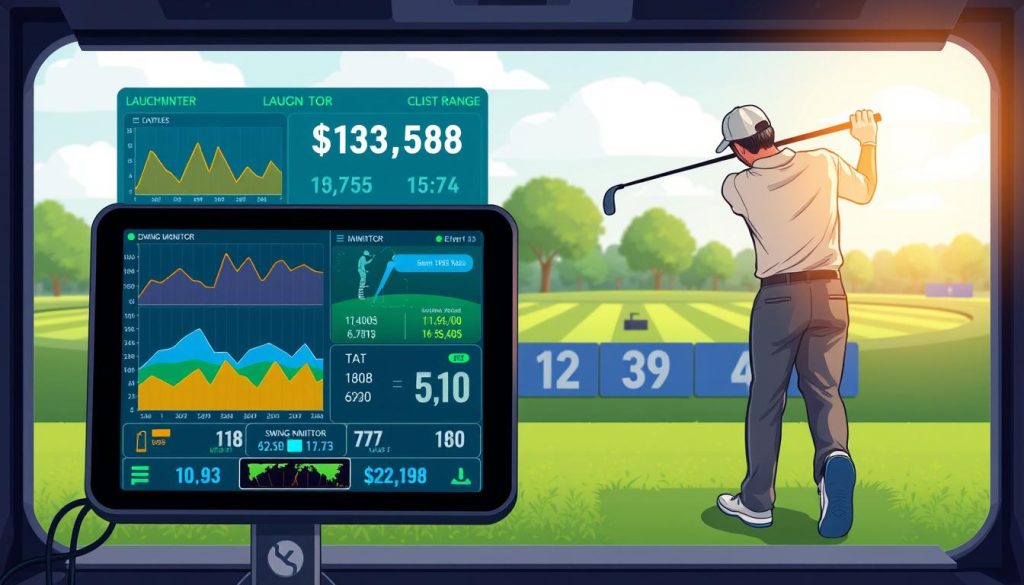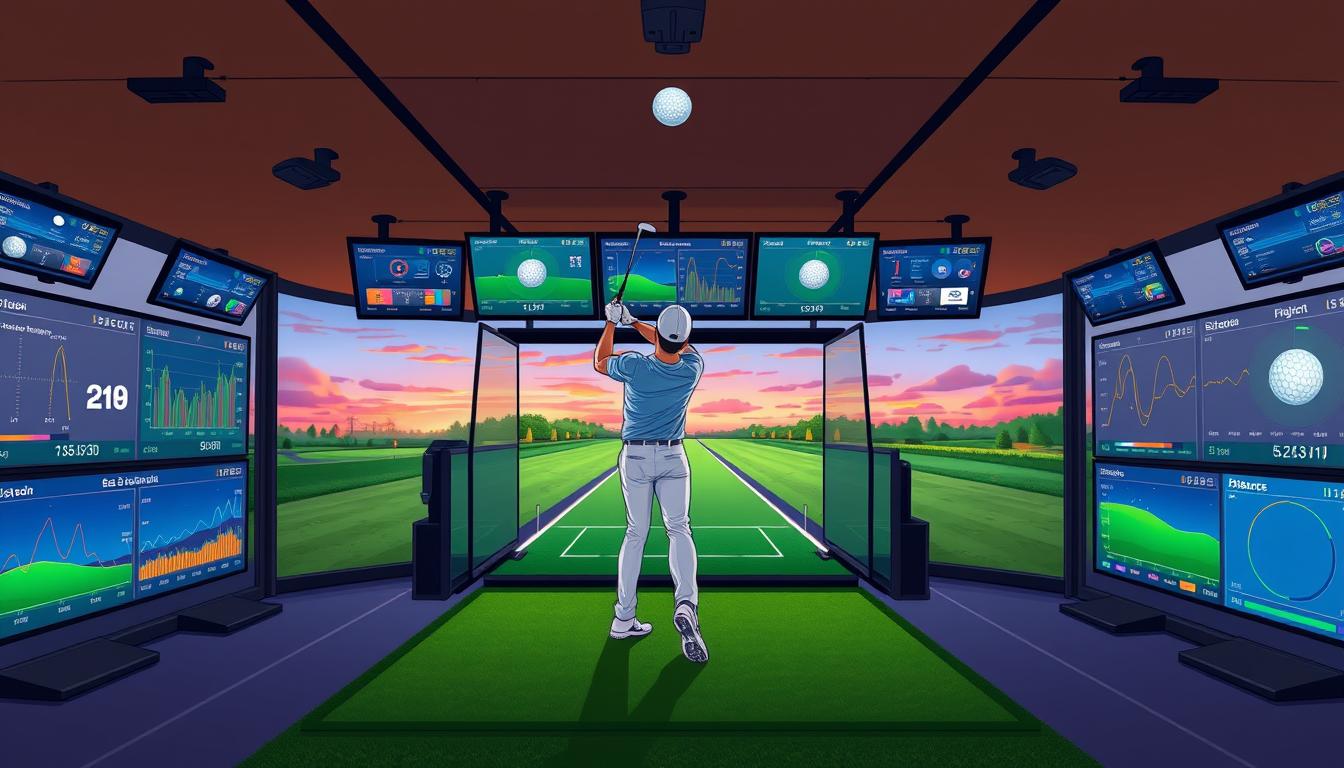Mastering your golf swing is key to better driving. This guide covers swing analysis and how to improve your game. You’ll learn how to boost your driving skills and play better on the course.
Understanding your golf swing is the first step to better performance. Focus on grip, stance, impact position, and follow-through. Each part is crucial for driving success. By improving these areas, you’ll swing more consistently and powerfully.
Technology has changed golf swing analysis, giving players detailed data. Tools like launch monitors, video recording, and software help analyze your swing. They show where you need to improve and track your progress.
Key Takeaways
- Proper weight distribution varies for different clubs
- Grip and posture fundamentals are essential for a solid swing
- Analyzing takeaway and impact position is crucial
- Technology tools provide valuable insights for swing improvement
- Regular practice and patience are key to enhancing driving skills
- Professional lessons can offer personalized instruction
Understanding Essential Golf Swing Components
A solid golf swing starts with mastering the basics. Let’s explore the key elements that form the foundation of a great swing.
Posture and Setup Fundamentals
Your golf posture sets the stage for a successful shot. Stand with your feet shoulder-width apart, knees slightly bent, and spine tilted forward from the hips. This balanced stance allows for proper weight distribution and rotational movement during your swing.
Grip and Hand Position Analysis
The right grip technique is crucial for controlling the clubface. There are three main types of grips: overlapping, interlocking, and baseball. Experiment to find which feels most comfortable and gives you the best control. Many modern grips feature alignment marks to help position your hands correctly.
Stance Width and Ball Position
Your stance alignment and ball positioning play vital roles in shot accuracy. For longer clubs, adopt a wider stance for stability. With shorter clubs like wedges, a narrower stance works better. Place the ball between the middle and front of your stance, adjusting based on the club you’re using.
| Club Type | Stance Width | Ball Position |
|---|---|---|
| Driver | Wide | Forward |
| Iron | Medium | Center |
| Wedge | Narrow | Back |
Remember, perfecting these components takes practice. Use training aids like alignment sticks to fine-tune your stance. Focus on a “one-line thought” technique, visualizing a diagonal line from grip to trail shoulder for a simplified swing approach.
Technology Tools for Swing Analysis
Golf technology has changed the game, giving golfers tools to improve their swing. From launch monitors to video recording and golf software, these tools offer deep insights into your swing.
Launch Monitor Benefits
Launch monitors are key for serious golfers. They track important swing data like club speed and spin rate. For example, the Voice Caddie T9 Golf GPS Watch helps with club selection and strategy.
Video Recording Techniques
Video analysis is a big help for those who learn visually. Set up cameras to see your swing from all sides. The Zepp Golf 2 Swing Analyzer, priced at $149, tracks club speed and tempo.
Golf Analysis Software Solutions
Golf software now offers detailed analysis tools. The ExPutt RG Putting Simulator provides indoor practice with detailed metrics. For a cheaper option, the BioMech Putt Sensor tracks putting metrics like stroke tempo.
| Tool | Price | Key Feature |
|---|---|---|
| Zepp Golf 2 | $149 | 3D swing analysis |
| Blast Golf | $115 | Putting analysis |
| Swingbyte | $130 | Comprehensive data collection |
When using these tools, focus on one metric at a time. This way, you can track your progress and improve your golf skills.
Golf Driving Analysis Guide
Golf stats tracking has evolved a lot since the late 1990s. Now, you can analyze your swing with high-speed cameras on your smartphone. These cameras can capture up to 240 frames per second in 4K resolution. This big change has changed how golfers collect and understand their performance.
Data Collection Methods
Today, many tools help gather swing data. Mobile apps, video recordings, and devices like HackMotion give deep insights into your swing. Coaches often record swings from different angles during lessons. This gives you quick feedback to get better.
Key Performance Metrics
When analyzing your swing, pay attention to these important metrics:
- Club speed
- Ball speed
- Launch angle
- Spin rate
These factors are crucial for the quality and consistency of your drives. By tracking them, you can spot areas to improve and see your progress over time.
Interpreting Analysis Results
Understanding your data is essential to better your golf game. Compare your metrics to pro standards to see how you stack up. Work on one or two areas at a time for better practice. Platforms like CoachNow allow for remote coaching, giving you personalized feedback and drills based on your analysis.
Regular use of golf stats tracking and understanding your data can lead to a 10% swing improvement after one session. This shows how technology is changing golf instruction and improving performance.
Mastering Launch Monitor Data
Golf launch monitors have changed how we analyze our swings. They give us key insights to better our game. We focus on launch angle, ball speed, spin rate, and clubhead speed.
Launch monitors vary in price, starting under $1,000. They track two main types of data: ball and club info. Knowing these metrics helps improve your game.

Ball speed and clubhead speed are crucial for longer shots. Launch angle and angle of attack help with ball flight. Spin rates affect distance, height, and direction.
| Metric | Importance | Impact on Performance |
|---|---|---|
| Ball Speed | High | Increases distance |
| Launch Angle | High | Optimizes trajectory |
| Spin Rate | Medium | Controls ball flight |
| Clubhead Speed | High | Enhances power |
When picking a launch monitor, think about its use, where you’ll use it, how easy it is to move, and the cost. Top models like Trackman give the most precise data. Mid-range options, like SkyTrak, offer good value and performance.
Learning to use launch monitor data helps you choose the right gear and make swing changes. This way, you can improve your golf game.
Understanding Shot Dispersion Patterns
Shot dispersion is key in golf. It’s how spread out your shots are from a target. Knowing this can help you play better and score lower.
Identifying Common Shot Shapes
Golf shots can be straight, fade, or draw. A straight shot goes right to the target. Fades curve right for right-handed golfers, and draws curve left. Knowing your shot shape helps in improving your game.
Analyzing Ball Flight Laws
Ball flight laws explain how your shots behave. They cover club path, face angle, and impact point. Understanding these laws helps you make better choices on the course.
Correcting Flight Path Issues
Struggling with slices, hooks, or pushes? You can fix them. Work on your grip, stance, and swing path. Drills can help improve your shot dispersion.
| Handicap | Dispersion Width (yards) |
|---|---|
| Scratch (0) | 15-20 |
| 5-handicap | 20-25 |
| 10-handicap | 25-30 |
| 15-handicap | 30-35 |
| 20-handicap | 35-40 |
Lower handicap golfers have tighter shot dispersion. Single-digit handicappers aim for 30 yards or less with a 7 iron. Pros aim for under 15 yards. By improving your technique, you can narrow your dispersion and increase your accuracy.
Advanced Swing Path Analytics
Mastering your golf swing means diving deep into advanced analytics. Focus on tracking your swing path and analyzing your club path. This will help you improve your swing plane and game.
Alignment sticks and video analysis are great for tracking your swing path. Use sticks on the ground to see your target line and swing path. Record your swings to spot any mistakes.
![]()
Proper rotation and lower body movement are key in the downswing. Start the downswing with your hips, then let your upper body follow. This makes your swing more efficient and powerful.
Wrist angles are important for optimizing your swing plane. Use tools like HackMotion to track your wrist angles. This helps you keep the right angles for better power and consistency.
A smooth transition from backswing to downswing is crucial. Practice drills to improve this transition. This will make your swing more fluid and effective.
| Swing Component | Tracking Method | Optimization Goal |
|---|---|---|
| Swing Path | Alignment sticks, Video analysis | Consistent path on target line |
| Club Path | Launch monitor data | Ideal in-to-out or out-to-in path |
| Wrist Angles | HackMotion sensor | Maintain proper angles throughout swing |
| Transition | Video analysis, Feel drills | Smooth backswing to downswing transition |
By using these advanced analytics in your practice, you’ll get insights to improve your swing. This will lead to more consistent and powerful shots on the course.
Impact Position Optimization
Improving your golf swing starts with mastering your impact position. Focus on the clubface angle, strike location, and impact dynamics. These elements can greatly boost your driving performance.
Face Angle Assessment
The angle of your clubface at impact affects the ball’s flight. A square face leads to straight shots. Open or closed faces cause fades or draws. Use alignment sticks to practice a consistent face angle.
Strike Location Analysis
Hitting the sweet spot on your driver is key for distance and accuracy. Use impact tape or spray to track where you hit the ball. Aim to hit it slightly above center for the best launch.
| Strike Location | Effect on Ball Flight |
|---|---|
| Center | Optimal distance and accuracy |
| High on face | Higher launch, less spin |
| Low on face | Lower launch, more spin |
| Toe | Gear effect, draw spin |
| Heel | Gear effect, fade spin |
Impact Dynamics Understanding
Good impact dynamics mean a flexed lead wrist and weight transfer forward. This leads to solid contact and efficient energy transfer. Compare your impact to pros using video analysis for tips.
Adjust your tee height for a shallower angle of attack. This helps hit the sweet spot and achieve a high launch with low spin. Many amateurs tee the ball too low, fearing a high ball flight. But, a higher tee often means better control and distance.
Remember, golf swing efficiency is not just about power. Focus on these impact factors to see real improvements in your driving game.
Spin Rate and Ball Flight Correlation
Golf ball spin is key to your shot’s path and how far it goes. Learning to control spin can really boost your game.
Backspin Optimization
Backspin control is vital for the right ball flight and distance. Drivers do best with lower backspin rates for longer shots. PGA Tour pros aim for about 2,686 rpm spin rate and a 10.9° launch angle for top performance.
Side Spin Management
Controlling side spin is crucial for straight shots. Side spin leads to hooks and slices, hurting accuracy. To cut down side spin, aim for a square clubface at impact and a neutral swing path.
Launch Conditions Analysis
Optimizing launch involves tweaking launch angle and spin rate. The PGA Tour’s highest launch angle in 2018 was 14.7°. Most golfers see distance gains with a positive attack angle.
Simulations reveal adding 17 yards to carry distance by increasing angle of attack from -5° to +5° at 160 mph ball speed.
| Ball Speed (mph) | Launch Angle (°) | Spin Rate (rpm) | Carry Distance (yards) |
|---|---|---|---|
| 171.3 | 3.8 | 980 | 290 |
| 157.2 | 20.5 | 5,450 | 260 |
Launch monitors help you tweak spin rates for various clubs and shots. Remember, your gear choice impacts spin too. So, pick clubs and balls that fit your spin needs.
Conclusion
Mastering golf driving analysis is key for better performance. Focus on ball speed, backspin, and carry distance. PGA Tour pros aim for ball speeds over 165 mph and backspin under 2,500 RPM.
Using technology for swing analysis greatly benefits your game. Launch monitors give data on swing speed, launch angle, and spin rate. With practice, patience, and professional help, you can improve your drive.
Remember, improving your golf drive is about technique, not just hitting harder. Joe Durant’s success, like winning the 2001 Bob Hope Chrysler Classic, shows the value of proper technique. Work on posture, tempo, and club face angle for better drives. With dedication, your game will get better over time.
FAQ
What are the essential components of a good golf swing?
How can I use technology to analyze my golf swing?
What are the key performance metrics in golf driving analysis?
How do I interpret launch monitor data to improve my drive?
What are shot dispersion patterns and why are they important?
How can I analyze and improve my swing path?
What is the importance of impact position in golf driving?
How does spin rate affect ball flight in golf?
What is the relationship between clubhead speed and overall performance?
How can I use angle of attack data to improve my drives?
Source Links
- https://hackmotion.com/analyze-golf-swing/
- https://www.pgaplay.co.uk/learn/master-your-golf-drive-a-comprehensive-guide-for-beginners/
- https://skillest.com/blog/a-comprehensive-guide-to-mastering-the-golf-swing/
- https://nationalgcla.com/the-basics-of-the-golf-swing/
- https://www.golfmonthly.com/buying-advice/best-golf-swing-analyzers-year
- https://practical-golf.com/best-golf-swing-analyzer
- https://www.bobbywaliagolf.com/video-analysis-remote-coaching/
- https://lookmygolfswing.com/products/online-golf-swing-analysis?srsltid=AfmBOoqVihhVAeurRaY4o_xh05LGX5BsJiP0WwpOLjYCJTIx9QZjoX1t
- https://www.playbetter.com/blogs/golf/understanding-golf-launch-monitor-data?srsltid=AfmBOoqt5NMMZiFlYxzXKyqzwEB1DKrdBPH7m-P5aVkxyNeMlPt97JOp
- https://swingfit.net/what-is-a-golf-launch-monitor/
- https://hackmotion.com/shot-dispersion-in-golf/
- https://www.tomfieldinggolf.net/tom-fielding-golf-school-japan—golf-improvement-blog/understanding-shot-dispersion-in-golf-a-players-guide-to-accuracy
- https://theleftrough.com/shot-dispersion-in-golf/
- https://parennialgolf.com/blog/understanding-trackman-data-complete-guide-swing-data-analytics
- https://www.carlofet.com/blog/understanding-launch-monitor-data-easy-golf-swing-metrics?srsltid=AfmBOooZ4K37BoXw9zmLk9UlNvt8cs5tduBLExvJnIiYk1aaz2x4V_Gd
- https://www.drawmorecircles.com/post/charting-your-unique-path-how-circles-transforms-golf-performance
- https://hackmotion.com/how-to-hit-driver-consistently/
- https://www.ncbi.nlm.nih.gov/pmc/articles/PMC9227529/
- https://hackmotion.com/golf-ball-flight-laws/
- https://www.trackman.com/blog/golf/the-ultimate-guide-to-understanding-trackman
- https://ping.com/en-us/blogs/proving-grounds/optimal-launch-and-spin
- https://teeitupcanton.com/understanding-your-golf-swing-data/
- https://pgaplay-pwa.azurewebsites.net/learn/master-your-golf-drive-a-comprehensive-guide-for-beginners/
- https://deemples.com/blog/golfing-techniques-experts-guide


